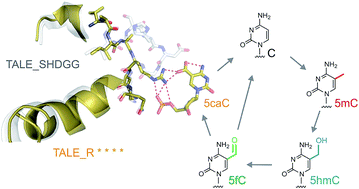Overcoming conservation in TALE–DNA interactions: a minimal repeat scaffold enables selective recognition of an oxidized 5-methylcytosine†
Abstract
Transcription-activator-like effectors (TALEs) are repeat-based proteins featuring programmable DNA binding. The repulsion of TALE repeats by 5-methylcytosine (5mC) and its oxidized forms makes TALEs potential probes for their programmable analysis. However, this potential has been limited by the inability to engineer repeats capable of actual, fully selective binding of an (oxidized) 5mC: the extremely conserved and simple nucleobase recognition mode of TALE repeats and their extensive involvement in inter-repeat interactions that stabilize the TALE fold represent major engineering hurdles. We evaluated libraries of alternative, strongly truncated repeat scaffolds and discovered a repeat that selectively recognizes 5-carboxylcytosine (5caC), enabling construction of the first programmable receptors for an oxidized 5mC. In computational studies, this unusual scaffold executes a dual function via a critical arginine that provides inter-repeat stabilization and selectively interacts with the 5caC carboxyl group via a salt-bridge. These findings argue for an unexpected adaptability of TALE repeats and provide a new impulse for the design of programmable probes for nucleobases beyond A, G, T and C.



 Please wait while we load your content...
Please wait while we load your content...